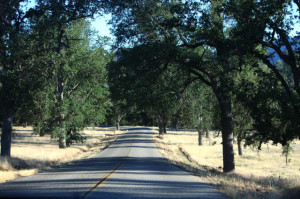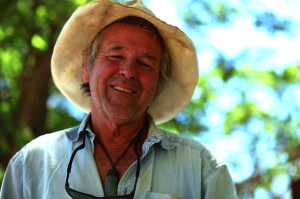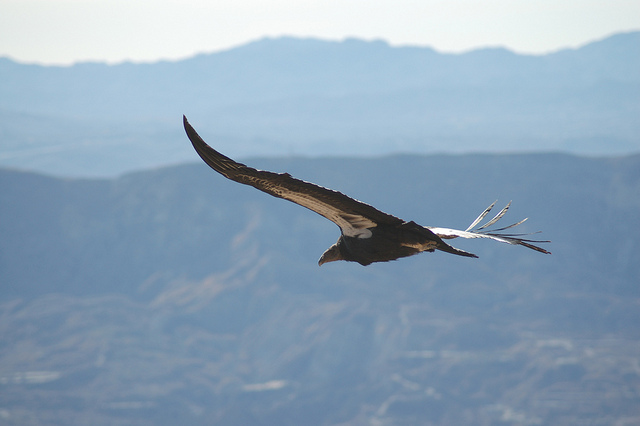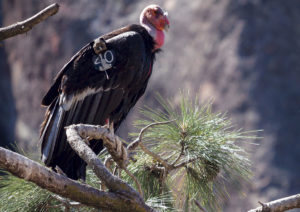It’s a good bet that journeys that begin on the solstice and involve California condors will be epic. And a recent trip to the Big Sur backcountry to understand how a new Central California oil boom could impact these awesome birds, and other vulnerable species, generated an epic set of questions.
We think of hydraulic fracturing, or “fracking,” as mostly an East Coast or North Dakota affair, but Central California might soon produce a whole lot of oil, with the potential for a host of environmental consequences that are still somewhat unknown.
At the heart of this story is the Monterey Shale, which stretches from northern Monterey County to Bakersfield, underpinning the inner Coast Range habitat that California condors glide over in their endless search for carrion.
The Monterey Shale contains an estimated 15.4 million barrels of oil, making it the nation’s largest domestic source of recoverable oil. But you don’t just stick a straw in and get the oil, which is tightly bound in rock. To get it out, there will be fracking, “acid jobs,” steam, and perhaps other methods that fit under the umbrella of “extreme energy.”

How far are we willing to go to slake our thirst for oil? As the oil boom unfolds, the condors will be watching.
And as Sacramento battles how it’s going to regulate fracking, what’s clear is that this relatively undeveloped and unpopulated land, the land of the condors, is at risk.
We here at Bay Nature have been pondering what’s out there and why we should care. If you do pull off Highway 101 as it leaves the congestion of Silicon Valley, skimming past Pinnacles National Park (site of the California Condor Recovery Program since 2003), the first impression is of flat valleys surrounded by a series of arid hills with the Santa Lucia mountains in the distance. It’s a place that few visit, but its quiet and stark beauty is the key to a landscape that could dramatically change if oil companies unlock the riches below the soil.
This is the first in a series of Bay Nature online pieces that will culminate in a feature story in the October issue of Bay Nature magazine.
Ground Zero: Monterey and San Benito counties
My journey began at 3 a.m. from the Bay Area, when I scrambled into a rented four-wheel-drive to explore the Ventana wilderness, a federally designated wilderness area in the Santa Lucia mountains along California’s Central Coast. As I cruised down Interstate 880, I pondered the irony of driving a gas-guzzler to better understand fracking’s effect on California wildlife.
 Fracking involves injecting large amounts of water and a mix of sand and chemicals at high pressure underground to fracture underlying rocks and release the oil trapped within.
Fracking involves injecting large amounts of water and a mix of sand and chemicals at high pressure underground to fracture underlying rocks and release the oil trapped within.
The areas the industry would be operating in include the oak woodlands of interior Monterey County, the few last remnants of habitat for species that once inhabited the broad expanse of the Central Valley. This is Steinbeck country: prime inner Coast Range habitat that features a mosaic of vegetation, including chaparral, oak and foothill pine woodland.
It’s not just condors out there. The Center for Biological Diversity (CBD), which sued the federal Bureau of Land Management (BLM) for failing to adequately assess the risks of fracking before granting new oil and gas leases in the area last December, warns that a number of vulnerable species are at risk: the San Joaquin kit fox, the blunt-nosed leopard lizard, and threatened South Central Coast steelhead, and more.
“Many of the areas proposed for oil development in California are some of our last, best public lands,” said Brendan Cummings, attorney for the Center for Biological Diversity (CBD).”They were never farmed, they were never turned into subdivisions.”
Oil spokespeople say fracking has long been safely used in California, and they say it could create thousands of jobs and bring billions in tax revenues. But environmentalists worry that traditional methods of fracking plus horizontal drilling could deplete and contaminate water supplies, trigger earthquakes, pollute air, and harm wildlife.
Deep in condor country
I was headed in the direction of Jolon, a tiny, unincorporated town that was the fictional setting for John Steinbeck’s novel To a God Unknown, which explores the relationship of man to his land. I took a right turn that led me towards the Fort Hunter Liggett military base and from there to the Los Padres National Forest.

I was paying a visit to actor Timothy Bottoms, who does dead-on spoofs of former President G.W. Bush and in his time off-stage lives on a ranch in the Ventana Wilderness. He sees condors regularly near his property.
Much of the land in the area is part of the Los Padres National Forest and Fort Hunter Liggett army base. As the road wound up to Bottoms’ ranch, the terrain transitioned to angular hills that only mountain lions, boar, deer and condors traverse with ease.
“The condor is the bird of life,” Bottoms said, as he led me across his property to a telescope trained on a nearby ridgeline.
The object of his fascination was a female bird that the Pinnacles program released in 2007 and that showed up near his ranch this spring. Bottoms believed this female had been uprooted from her nest by military helicopters, just one of the threats to condor existence in the area. The Ventana Wildlife Society (VWS) had sent up a biologist to track down the bird, and found an egg, but on a return trip that day failed to find a hatchling or a nest.
Bottoms worries that the region is prime for oil development, even as oil extraction has been a fact of life in California for decades.
“Now we’re at the end of the resource and they’re trying to get the last drops,” Bush said. “It’s an assault on earth. They pump chemicals into the ground to extract the oil.”
Some local conservationists, who have long battled the immediate threats of low-flying military aircraft and leaded bullets from hunters, don’t see fracking as the main danger to the condor’s existence.
“There may be other issues to be worried about but at first glance, it doesn’t seem to be a threat to condors in the wild,” Kelly Sorenson, executive director of VWS, wrote in an email.
But others worry about the cumulative impacts of road building, water use, wastewater disposal, and other environmental tolls on the landscape — in short, the entire infrastructure that would be needed to support oil extraction.
Rachel Wolstenholme, Pinnacles’ condor program manager, points to fracking’s impacts on quality and quantity of local water sources, which could in turn affect the viability of local ranches and the wildlife populations they have come to support.
“We rely on ranching and hunting to feed these birds,” she said. “If those activities disappeared because of the indirect impact of fracking on water, that would hurt the birds and the ranchers themselves.”
[slideshow]
Preview of next installment: Above the Shale
Missing from discussions about extreme methods of energy extraction in the Monterey Shale is a sense of the landscape that sits above this geological formation, which extends from Southern California to Monterey County, with smaller outcroppings as far north as the Berkeley Hills.
In our next installment, Above the Shale, we focus on three towns at the intersection of the fracking boom: Aromas, a small town at the intersection of Monterey, Santa Cruz, and San Benito counties; Lockwood in southern Monterey County; and Paicenes, a ranch town in San Benito County.
These three communities have either experienced seismic surveying for oil or are near leases that have been auctioned for oil exploration, or both. Some locals fear that fracking, acid jobs, and steam technology will deplete and contaminate their water, harm wildlife, and turn their backyards into industrial wastelands.
Want more background on fracking? Check out a recent National Geographic feature on fracking, including this video with animation about the Bakken Shale oil rush in North Dakota:
Sarah Phelan is a contributor to Bay Nature and is leading our coverage on Extreme Energy in the Monterey Shale.





